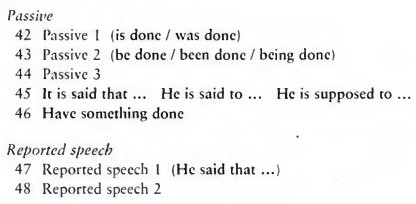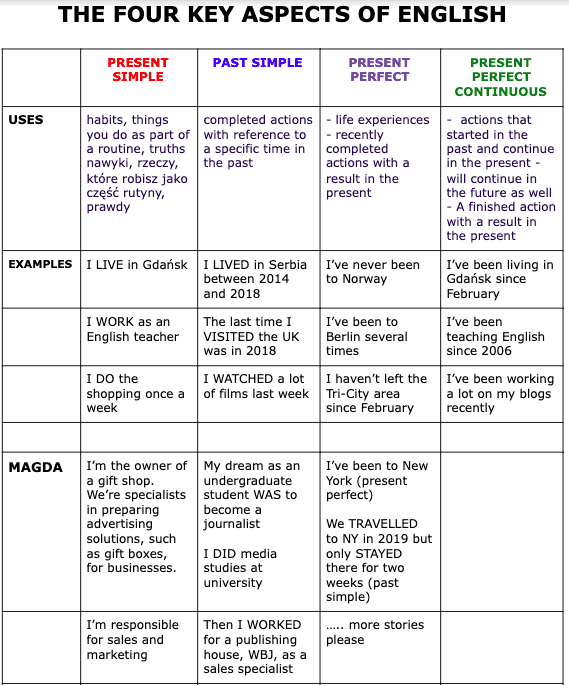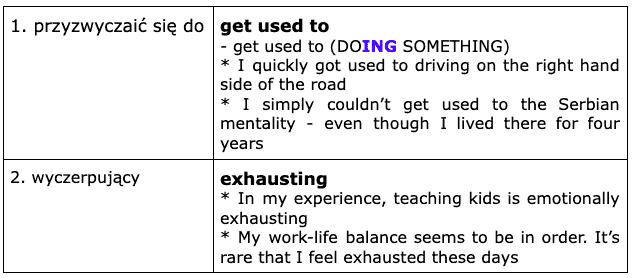How can I improve my English? – ULTIMATE GUIDE to a common question
How can I improve my English? … Possibly, the most frequently asked question I’ve had to deal with in the fifteen years I’ve been teaching English.
My job now is to delve into all my experience, knowledge and beliefs and leave you with little doubt as to how you can get your English in the fast lane.
This is the ultimate guide to answering the question “How can I improve my English?”.
Let’s dive in.
First things first - know why you're asking the question “How can I improve my English?”
So, you take private English lessons or attend a language school. You do your homework and complete exercise after exercise in grammar workbooks. Of course, you immerse yourself in English by listening to Youtube clips and so on.
However, you just feel that you’ve hit a brick wall and can’t reach a state of advanced level/proficiency level fluency.
Actually, there is a very good reason why you’re at the end of the line.
You’re stuck at what’s known as the “intermediate plateau”.
In essence, all that super swift progress you made from elementary to intermediate level has been overtaken by stagnation and frustration.
As you can see in the diagram below, the actual learning curve is far different from what you imagined when you started learning English. There is no direct and linear route to fluency and proficiency level:

You might be spending an enormous amount of time reviewing previously learned language and grammar rules.
Well, it’s time to free yourself from this monotonous and seemingly hopeless cycle.
You need an innovative set of language learning strategies and a concrete plan to elevate your English to an advanced level.
Let’s check out the steps which will significantly boost your level of spoken English:
1. Grammar isn’t everything - Narrow down the areas of English grammar you actually need to focus on
Unfortunately, students of English receive little guidance from educators regarding which grammar points, verbs and phonological phenomena commonly appear in spoken English.
Indeed, educators and syllabus writers tend to have a 'learn everything under the sun' approach.
Take self-study grammar reference and practice books with a pinch of salt
I’ve just had a browse through the contents of Raymond Murphy’s book English Grammar in Use. This is a self-study reference and practice book for students at the intermediate level.
Presumably, you’re trying to improve your spoken English. Therefore, you should avoid studying units such as the ones below:


Relative clauses and the passive voice are extremely uncommon in everyday speech.
It’s vital that you separate what’s useful for written English from what’s useful for spoken English. Moreover, just because something looks like it might be related to spoken English, such as reported speech, it doesn’t mean you have to focus on it in great depth.
Tenses and aspects
There are four aspects, belonging to two tenses (past and present), which you could do with familiarising yourself with:
- present simple
- past simple
- present perfect simple
- present perfect continuous
In recent years, I’ve tried my utmost to break down the tense/aspect system for my students:

Creating personalised sentences - true sentences about yourself, your experiences, and current situation in your life - is far more beneficial than doing exercises in grammar workbooks. With regular revision and rereading of these sentences, you might find that you’re able to remember them in future conversations. Hence, you’ll always have a stock of ready-made and grammatically correct sentences "swimming" around your mind when you speak English.
Other key grammar structures which are common in spoken English
(a) Used to (do/happen) - something happened regularly in the past, but no longer happens:
Graham used to spend a lot of money on vinyl records. These days he can’t afford it
(b) Modal verbs - with reference to the past and future:
I can do it when you want (implied future use)
I should have done it yesterday (past)
(c) Would - when imagining a situation:
I’d love to live by the sea in Croatia
(d) Second conditional - imagining a situation (in the present):
If I knew where she lived, I’d give the letter to her personally
(e) Third conditional - imagining a situation (in the past):
If I’d known she was in town, I would have gone over to see her
(f) verb + -ing:
- avoid + ing - He tried to avoid answering my question
- fancy + ing - Do you fancy going out tonight?
- enjoy + ing - I enjoy playing snooker
(g) verb + to:

Verbs commonly followed by a 'to'-infinitive
I agreed to help Johnny with his dissertation
My aunt learnt to drive when she was in her fifties
(h) Preposition (for / about / in etc.) + -ing:
Jessie’s terrible at learning languages
Are you interested in working for us?
What are the advantages of living on the outskirts of a big city?
We talked about visiting Jane in Canada
I congratulated Jason on getting a new job in London
2. Personalise, personalise, personalise
It’s all very well using flashcard apps such as Anki in your downtime to help you remember words.
Flashcards with audio, images and full sentences containing new words - all very admirable.
But if you really want to get to the heart of the question “How can I improve my English?”, you’re going to have to create PERSONALISED sentences containing new words and phrases.
That’s right. I recommend you to create one or two true sentences about your hobbies, your life experiences, your personal philosophy or people close to you.
Frankly, I wouldn’t have learned to speak Serbian in the super quick time I did if I hadn’t personalised all the words and phrases I was coming across while living in Novi Sad, Serbia.
How to personalise newly learned words and phrases?
Personally, I’m not into flashcards.
I believe there’s nothing better than a good old google doc to create your own Word-Phrase Table.

I’ve pretended to be a Polish learner of English. In my view, there’s nothing wrong with using your first language as a trigger to recall English words and phrases.
You can record all of your personalised sentences after a star (*).
Why should you personalise newly learned words and phrases?
When it comes to personalisation, it’s all about personalised sentences "swimming in the brain".
Essentially, if you constantly go over your personalised sentences, whispering them to yourself along the way during the revision process, you’ll find that they’ll automatically come to mind during conversation.
Sometimes, you might not be able to recall whole personalised sentences when you’re speaking a second language. It might just be certain collocations or chunks of words from these sentences. Nevertheless, that’s still enough. Having a stock of chunks in your mind is another contributing factor to spoken fluency.
Overall, the essence of spoken fluency is having this endless stream of personalised sentences “swimming in the brain” and on the tip of your tongue during real-life conversations.
3. Make sure you’re DEEPLY aware of your “fossilised” language errors
Is this a familiar situation for you? No matter how often your teacher corrects you, you just can’t seem to stop making the same mistakes.
Essentially, these mistakes have become “fossilised”.
“Fossilisation” refers to errors which you’ve made so many times that they’ve simply become part of your natural speech.
It doesn’t matter how many times a teacher corrects you while you’re speaking, or indeed how many times they point out fossilised errors after class, you still continue to make them.
How to fix fossilised errors
In order to stamp out your fossilised errors, you must attack the issue from a range of interconnected angles.
First of all, you need to begin to record your own voice so you can monitor your progress in eliminating certain errors over time.
Creating a table like the one below in Google Sheets will help you to record your fossilised errors. Listening to your voice recordings from your classes, for example, will enable you to keep a record of how often you make the errors each week or month etc.

The personalisation method mentioned in point 2 above must also come into play.
It’s one thing having the correct form in your table. However, creating a column with full personalised sentences containing the correct form will dramatically increase the possibility of eradicating fossilised errors.

I’m a big believer in visualisation as well. Indeed, I believe there’s a connection between visualisation and the rate at which one can eliminate fossilised errors. Here comes some colour and a different font for the troublesome word:

All in all, it’s obvious that you need to put in a great deal of effort to tackle the “how can I improve my English?” conundrum.
4. Don’t separate the study of grammar and vocabulary
If you could just get your hands on the book - Longman Student Grammar of Spoken and Written English (SGSWE) - it’d change your whole view of what speaking English is all about.
The most distinctive innovation of SGSWE is that it’s a corpus-based grammar.
A corpus is a collection of linguistic data, either written texts or transcriptions of recorded speech, stored on a computer.
Why should English language learners who are eager to improve their English refer to SGSWE?
The corpus used for SGSWE - the Longman Spoken and Written English Corpus (the LSWE Corpus) - contains roughly 40 million words of text.
Such an extensive collection of data provides ambitious learners of English not only with a sound basis of structural rules and grammatical patterns, but also a riveting insight into how English is used for communication.
A key advantage of the SGSWE over traditional grammars is the book contains over three thousand examples of English in use. These are authentic cases of language use from the corpus. Hence, readers get a feel for how real people use real language. There are no invented examples that sound artificial.
Lexico-grammatical patterns
To my mind, the most distinguishing feature of the SGSWE is the way it brings together the study of grammar and vocabulary.
At school, you were used to teachers treating grammar and vocabulary as two separate areas of the English language.
However, this separation is artificial. Competent speakers of English bring together their knowledge of word behaviour (lexis) with their knowledge of grammatical patterns. Hence, we can say that these two features of language interconnect in lexico-grammatical patterns.
To illustrate the nature lexico-grammatical patterns, think about the set of verbs that commonly coexist with a that-clause (e.g. think, know, say):
- I know that she wants to visit but I haven’t got the time to host her and cook for her
There’s a different set of verbs that predominantly go together with a to-clause (e.g. want and plan):
- I want to leave this city as soon as possible
- I’m planning to study in Belgium
Less auxiliary verbs and more lexical verbs please
One of the main issues with school-based English language syllabuses is that they overemphasise the learning of auxiliary verbs.
Auxiliary verbs, such as will, be, have and can, tend to precede a main verb to help express the main verb’s tense or main purpose, for example, to form a question. Here’s an example of an auxiliary verb in action:
I think they will buy a new car, but not this year
Therefore, the main verb is buy. Will merely acts as a 'helping' verb as it doesn’t convey any mood or voice. It only provides grammatical information which buy doesn’t provide.
So, my argument is that you need to focus on common lexical verbs. Unlike auxiliary verbs, lexical verbs (or ‘main verbs’) represent a subject's action or express a state of being. Hence, lexical verbs don’t carry a grammatical meaning.
The diagrams below, taken from the LSWE, are very revealing when it comes to the most common lexical verbs and their prominence in conversation:


You should be interested in studying lexical verbs such as get.
The versatility of the word get is extraordinary. It has such a wide range of meanings and grammatical patterns.
For instance, it can be used like an auxiliary verb to create a passive construction, the so-called ‘get passive’:
- I got caught speeding twice last year
Let’s also pay heed to the vast number of idiomatic multi-word phrases which contain get:
- I had to get rid of that ugly old armchair (get rid of = throw away an unwanted item)
- He thought he could get away with cheating on his taxes (get away with = escape punishment)
5. Engage yourself in HIGH-QUALITY listening
To my mind, TED talks are a goldmine when it comes to improving both listening and speaking skills.
Let’s check out how you can exploit this TED talk by British sailor Tracy Edwards to advance your listening and speaking skills.
Off-the-cuff speaking
Compared with many other TED talks, Tracy’s talk represents speaking off-the-cuff. That means she delivers her speech naturally without checking slides or notes. Therefore, this conversational style generates a greater range of expressions, lexico-grammatical combinations and intonation patterns found in everyday spoken English.
Start fast, then move slow
In terms of improving your English skills, one of the most alluring features of TED talks is the speed setting.

I don’t pretend for one minute that intermediate level learners would find it easy to comprehend everything a presenter says at a speed of 1.25x or 1.5x. However, you need to challenge yourself.
In fact, I’d recommend listening to every talk three times - at 1.5x, 1.25x and normal speed. In this way, you’ll get used to native speakers who speak quickly. As you listen to more and more talks, you’ll find it much easier to understand everything at normal speed.
How can I improve my English? - The Final Chapter
The question “How can I improve my English?” is not an easy one to answer.
In this post, I’ve examined five key areas which I believe most learners haven’t considered in their quest for improvement.
For serious improvement, you will need to think outside the box a little bit. You need to be original, willing to take risks, dedicated and, most importantly of all, supremely organised.



